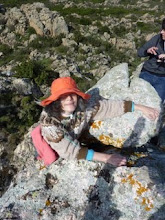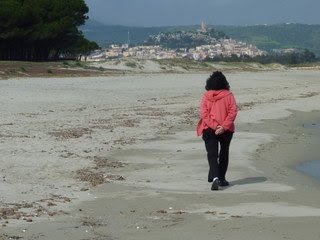First, to get some context, let's start with a map of Sardinia (above), taken from Wikipedia, that shows the various areas of Sardinia and many (but nearly all) of the towns, providing their names in both Italian and Sardu, which is the traditional language here, spoken in many dialects depending on the locality. Please note that, so far, we've only visited the three northern areas, and not nearly all of them. Therefore, anything we say here does not necessarily apply to, say, the southern coast, which is dominated by Cagliari, a substantial urban area (about a half-million souls) with a completely different economic, social and cultural dynamic.
Anyway, except for the towns on the east coast near to our house, which we visit or pass through almost every day, most of our 'research' to date covers the middle part of the island - look slightly off-center to the northeast of the map above - loosely known as the Barbagia. As the name implies, the Barbagia is where the 'barbarians' live - that is, the native Sardinians who largely resisted the 'civilizing' efforts of various conquerors, starting with the Carthaginians and the Romans, and ending with the hordes of (mainly) Italian mainlanders who regularly 'invade' the beach areas (especially in the Costa Esmeralda in the far northeast) every summer.
Each of the towns we've visited has a different feel, but they tend to have a lot in common. First of all, with the exception of Nuoro, the area's main city and a provincial capital, they are all quite small and feel very rural. Often they are surrounded by mountains and quite hilly themselves, making for some very picturesque settings. The rural areas between them are typically very 'empty' - nothing but mountains and pasture, with sheep in abundance.






After your earlier post that mentioned the different dialects of Sardinia, I found this map ( http://www.sufurriadroxu.it/public/?page_id=63 ) of the dialects of Sardinia....... The history of the place (as most places I suppose) sure is reflected in the diversity of tongues!
ReplyDelete